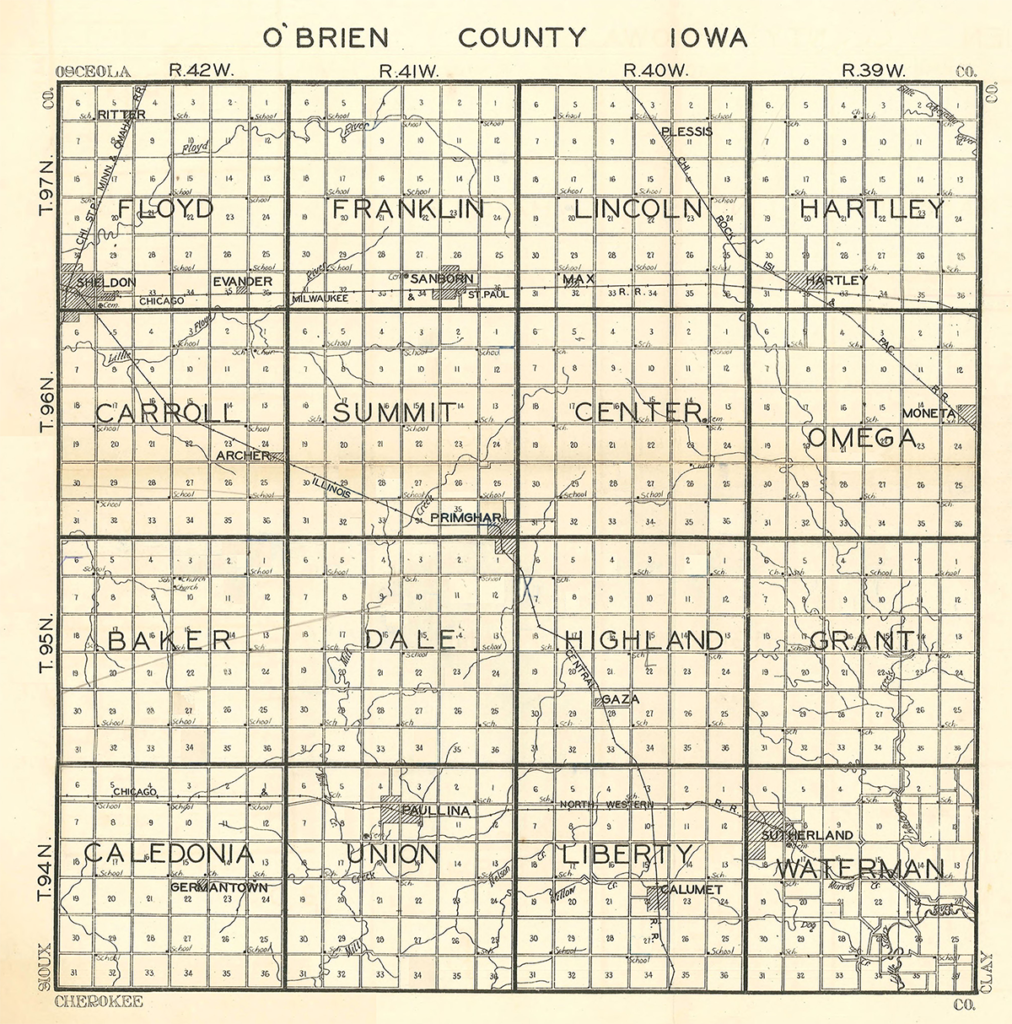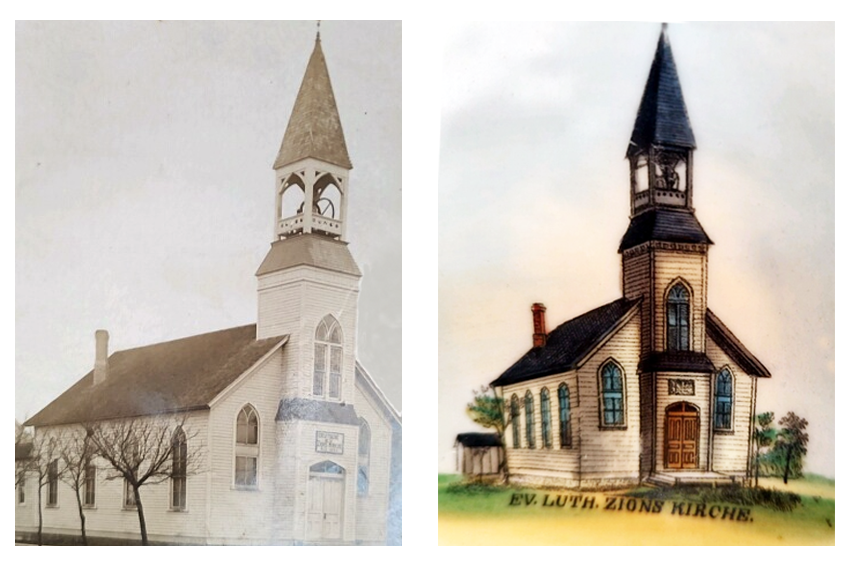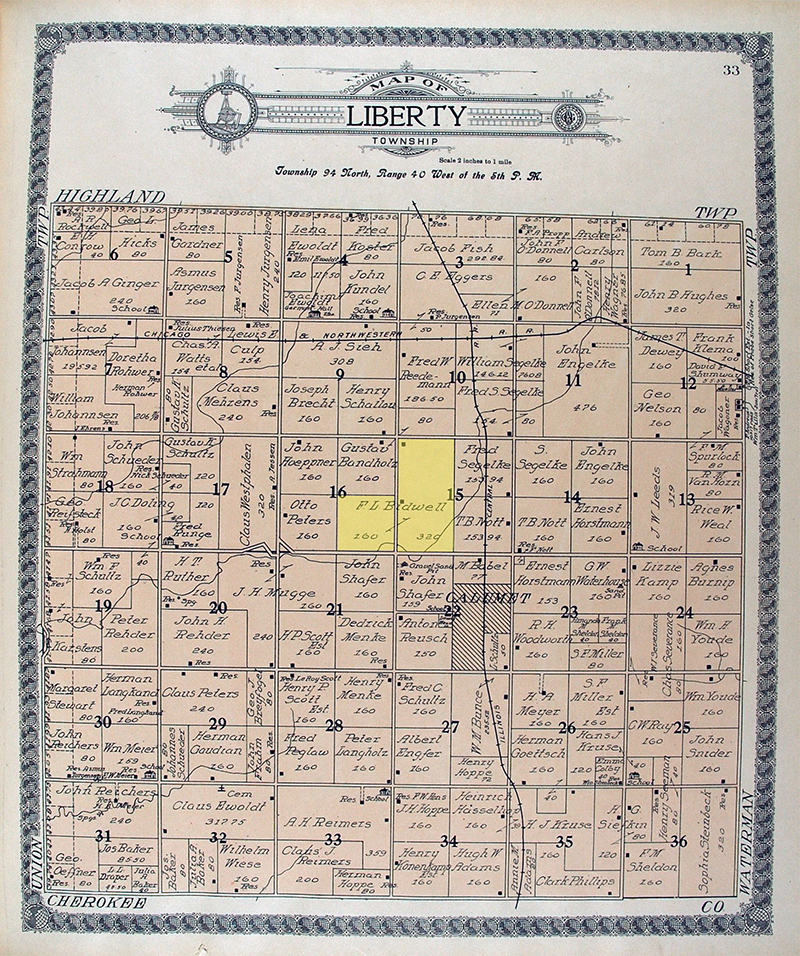A Predominantly German-American Community
The idea of a Calumet German Band in early-20th-century Liberty Township, O’Brien County, Iowa, is reflective not of a small affinity group within the region. It is emblematic of the region. For all but two of the 22 band members, German ancestry defines their family heritage, and that heritage characterizes the immediate region also.
Other Resources in This Section
• Band Members by the Numbers
• WWI & Anti-German Sentiment
A well-known immigrant experience is the phenomenon of “chain migration”: an early vanguard seizes opportunities, achieves a measure of success, then sends word to other family members and friends to join them. Recognizing how a shared language and cultural affiliation can offer advantages for easier acclimation, the next wave of immigrants expands the nascent community, and soon a town, a township, and an entire county can reflect a predominant ethnic and cultural identity.
Such is the case with Calumet and Liberty Township. Immigrant settlement in the upper Midwest — Iowa, Nebraska, Wisconsin, Minnesota, and the Dakotas — in the mid- to late 19th century already reflected a large influx of German immigrants. According to the German American Heritage Center and Museum, half of all residents in these states in the year 1900 reflected German heritage.(1) Even today, individuals with German heritage comprise the single largest ethnic group in Iowa.(2)

For the specific environs of Calumet, the proportion was higher. An informal analysis of the 1900 census for Liberty Township shows that two thirds of the heads of households and their spouses reflected German heritage. Slightly smaller proportions would likely be the case for nearby townships to the north and west — Highland, Union, and Caledonia (including the towns of Gaza, Paullina, and Germantown) — but the proportion would be more appreciably smaller for Waterman Township to the east (including the town of Sutherland). There, the mix of nationalities of origin was somewhat more diverse. So Liberty Township is a particular German-American locus.
As noted on many individual band member bios, the immigration path for a number of these families was strikingly similar. The passenger railroad crossed the Mississippi River into Iowa at Davenport, in Scott County, sometimes referred to as the “Ellis Island of the Midwest.” Many German immigrants remained there. Joseph Eiboeck (1838-1913), a prominent journalist and newspaper editor, described the city in 1900 as “the most German city, not only in the State, but in all the Middle West, the center of all German activities in the State.”(3) But other families also moved on, to nearby German enclaves like Tama County, or in stepwise fashion, first to Tama County and then to points further west and northwest.
Language and Religion

The German immigrants to Liberty Township around 1900 largely reflected the specific region of Schleswig-Holstein (Low German: Sleswig-Holsteen), the northernmost state of modern Germany, which abuts Denmark and is situated on the lower portion of the Jutland Peninsula.(4)
For these families, their everyday language was largely Plattdeutsch,(5) or Low German, rather than standard German or High German spoken elsewhere. Part of the West Germanic language group, Plattdeutsch/Low German is typically spoken in northern Germany (i.e., coastal areas, thus “low” in elevation) and northeastern parts of the Netherlands. Although it can be thought of as a dialect of either German or Dutch, or something of an amalgamation of the two, linguists generally categorize it as a separate language.

In this U.S. immigration era, those who emigrated from this area of Germany also were generally adherents of the German Lutheran faith, an important facet of their lives as they settled in the new world. Early families in Liberty Township quickly organized the German Evangelical Lutheran Church, in 1891, and a church building was erected in 1892. Among the organizers were several families of Calumet German Band members, as noted on their bios. Church services were held in German in addition to English even into the 1950s.
In 1948, the church was remodeled and expanded, and a basement was constructed to house a social hall. Another renovation in 1976 added a larger entrance and vestibule to the building. With these renovations, and with several changes of affiliation and name,(6) the church continues to thrive into the 21st century.
A Methodist church was also established within Calumet at the same time as the German Evangelical Lutheran Church, but its tenure was short-lived, and the church was discontinued in 1937.
Ethnic Tensions at the Turn of the Century
The German immigrants to Calumet and Liberty Township did not receive a uniformly welcome reception by all members of the surrounding region. Reflecting an age-old global story of immigration and (in)tolerance, tensions sometimes arose between old and new — between more established groups and newcomers — as well as between and among ethnic groups. The time during which the Calumet German Band was formed and existed was an especially fraught era, as the U.S. prepared to intervene militarily in World War I on the side of the Allies. In the run-up to the war, as well as at the time of the U.S. involvement beginning in April 1917 and continuing throughout the war, there was a wave of anti-German sentiment and personal violence both nationally and in Iowa. The state’s governor, William L. Harding (1877-1934), capitalized on this sentiment with the issuing in May 1918 of an unprecedented edict, the “Babel Proclamation,” which forbade the speaking of any language in public other than English. See a more extensive discussion of anti-German feelings in a companion section, “WWI & Anti-German Sentiment.”
Farming in Liberty Township

The German immigrants to Liberty Township, who generally were farmers in their native land, established themselves in northwest Iowa because it offered good farmland. In 1909, these farms were small in size and diverse in their output. An examination of the plat map for Liberty Township in 1911 shows typical farms ranging from 80 to 160 acres (one eighth and one quarter, respectively, of a full section, or one square mile), with the farm of F. L. Bidwell an outlier at 480 acres. (Incidentally, F. L. Bidwell was a granduncle of Calumet German Band member Newell Bidwell.)
As discussed in the “Town and Township” section, some of the fields in this era would have been kept as pastureland (grazing for household livestock and occasionally larger herds), but a growing recognition of the land’s value for grain production would steadily reduce the acreage devoted to pasture and family use and increase that devoted to corn, oats, barley, wheat, and eventually soybeans, for sale on the commodity markets. In this era, the type of equipment was changing (e.g., John Deere had developed a commercially successful steel plow that could cut through tough native prairie; Cyrus McCormick and others had developed mechanical reapers), and the power for that equipment was changing also — from oxen to draft horses, and occasionally mules, then to steam engines (for grain threshers) and eventually to gasoline- and diesel-powered tractors of ever increasing size. The farming families of these Calumet German Band members were adopting these new methods in this era.
Likewise, as discussed in the “Town and Township” section, railroads made it possible for these farmers to transport their grain crops and also livestock to regional markets. In fact, the town of Calumet owes its existence to the extension of the Illinois Central Railroad in 1887.

Farmsteads in this time and place often comprised a one- or two-story wooden-frame house, an outhouse (indoor plumbing was typically retrofitted into houses only in the following decades), and several outlying buildings: barn with hayloft; other livestock enclosures and shelters; silos, grain bins, and corn cribs; buildings for equipment storage; and a cistern and well for livestock and household use. A photograph (above) fairly contemporaneous with the Calumet German Band photo shows the farmstead of Henry J. Schallau (1874-1934) and Rosa Brecht (1871-1950), which was directly across the road from the farm where band member Charles Bandholz grew up and where he himself eventually farmed.
Band Members by the Numbers
Age
A glance at the Calumet German Band photograph shows immediately that the band members are youthful. Among the members are three young teenagers — 12, 13, and 14 years old — with one outlier, Ralph Langley, at 28 years of age. The mean age of the band at the time of the photo is 19.2 years. (Without Langley, the mean age drops to 18.8 years.)
Heritage
Of the 20 band members who reflected a German heritage, six had themselves been born in Germany (their immigration years from 1891 to 1904), and for the remaining 14 members both of their parents had generally been born there. (For one member, Allie Sohm, his father had been born in Austria rather than Germany, and for another, Henry Friedrichsen, his mother had been born in Sweden.) The two band members who did not reflect a German heritage — Newell Bidwell and Ralph Langley — had an English heritage on both their paternal and maternal sides.
Education
All band members could read and write English, but for a majority of them their schooling did not continue past the 8th grade — an altogether typical educational level for this era, especially for members of farm families. Two members (John Rohlf and Herman Steinbeck) had schooling only through the 6th grade, but five members had some high school — one year for Earl Smith, three years for Allie Sohm, and all four years for Ralph Langley, John Mehrens, and Hans Sievers.(7)
Marriage and Children
All of these individuals married except for Newell Bidwell, who died at a young age, and 18 of these 21 members had children. Most members (13) had from one to three children; the others were William Eggers (seven children); Ralph Langley (five); and Henry Mugge, Harry Rochel, and Ernest Shafer (each with four). Three men suffered the loss of children in infancy or early youth (in addition to their surviving children), and one man (Nick Jessen) had no surviving children because his sole child died in infancy.
For the 18 members who did have children, the mean number of children surviving to age 12 is 3.0. Expanding the denominator to the 21 married band members, the mean number of children is 2.6. And if all 22 band members are included, the mean number is 2.5.
Profession and Military Service
Four members of the Calumet German Band served in World War I (Newell Bidwell, John Brumm, Emil Propp, and Earl Smith). In their professional lives, more than half of the members — 12 of 22 — relied on farming or farm-related services as their primary occupation. But several more were carpenters, butchers, and plant specialists, deploying skills they would have learned in childhood within a farming community.
Residence
Iowa was the sole state of residence for eight of the 22 members. If the region of residence is expanded to the contiguous states of Iowa, Minnesota, and South Dakota, that number rises to 16. Only six members spent a substantial portion of their lives (work lives or retirement) in states other than these: Ohio for John Brumm; Colorado for William Shafer; and California for Henry Andersen, Ralph Langley, John Rohlf, and Earl Smith.
Lifespan
The mean lifespan of these 22 individuals was 68.1 years. The spread of lifespans was extreme; Newell Bidwell died at 21 and Charles Bandholz at 30, but Ralph Langley died at 97. If these three individuals are removed as outliers, the mean lifespan was 71.1 years.

Companion Section
As mentioned above, a companion section discusses “WWI & Anti-German Sentiment.” The next major section, “Musical Issues,” discusses what is known about the band’s purpose as well as its music and instrumental makeup, and “Band Member Bios” provides biographical snapshots of all 22 members.
Footnotes
(1) German American Heritage Center and Museum (Davenport, Iowa), in an analysis of the 1900 federal census. https://gahc.org.
(2) “Thinking about Immigration,” from German Iowa and the Global Midwest, a public humanities project housed at the University of Iowa. The project brings together material originating from the State Historical Society of Iowa, the Iowa Women’s Archives, the German American Heritage Center, and University of Iowa special collections. https://germansiniowa.lib.uiowa.edu.
(3) Eiboeck’s comment appears in his book, Die Deutschen von Iowa und deren Errungenschaften (The Germans of Iowa and Their Achievements), which has not been translated in full. Its translation is continuing incrementally as a project of University of Iowa students in the university’s Department of German. See https://germansiniowa.lib.uiowa.edu/exhibits/show/eiboeck.
(4) The regions of Schleswig and Holstein, while historically the home of ethnic Germans, had been under various forms of political control over the centuries (the Danish king, the Holy Roman Empire, independent duchies, the Prussian state). Territorial disputes led to two small wars between Denmark and Prussia in the first half of the 19th century — the first achieving victory for the Danes and the second leading to victory for the Prussians. German defeats after both World War I and World War II led to changes in territory, resettlement of refugees, and modern borders.
(5) There are many other name variants and spellings, such as Plattdüütsch and Neddersassisch. A variant of Low German is also spoken by Mennonites.
(6) There are slightly conflicting accounts by the church itself of its original name, but subsequent name changes were necessary to reflect denominational mergers in the mid-20th century as part of the ecumenical movement. In one account, the church was established as the German Evangelical Lutheran Church, and the word “Lutheran” was dropped from the name in 1920. In another account, it was established as the German Zion’s Evangelical Church. But the early painted illustration seems to indicate that at least informally the church was known as Zion’s Evangelical Lutheran Church. At any rate, in 1934, due to a merger of the Evangelical Synod of North America and the Reformed Church in the U.S.A., the Calumet church became the Zion Evangelical and Reformed Church. Another national merger joined the Evangelical and Reformed Church and the Congregational Church to become the United Church of Christ. Following this merger, the Calumet church in 1961 voted to change its name to correspond with the denominational name, becoming the Zion United Church of Christ.
(7) Four band members — Charles Bandholz, Newell Bidwell, Henry Friedrichsen, and Nick Jessen — died before the 1940 census, which was the first to specifically report the “highest grade completed” instead of reporting general literacy. Hans Sievers indicated having taken one year of college, but this is difficult to confirm.
